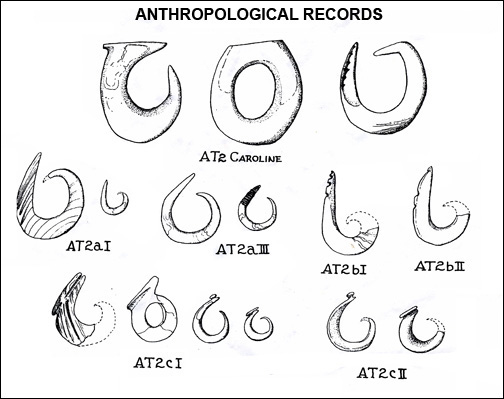

For years I’ve been fascinated with the Chumash style circular hook made from abalone shell. The Chumash are California’s seafaring indigenous culture. Though not all Chumash people ventured onto the Pacific, the group built large (30 meter), and well-designed plank canoes (to view a contemporary Chumash reproduction visit http://sanctuaries.noaa.gov/maritime/cultures.html). They ventured off shore as far as the Channel Islands, and they fished for ocean fish. They also fished from the shore. Hooks were designed for specific fish species.
Drawings of their circular hook raised questions in my mind about both the method of its construction and its hooking technique. Its hook gap looked too narrow to effectively hook fish the same way modern hooks do. Had the hook been offset, creating a larger gap than the two-dimensional drawings revealed? Or, was the narrow gap necessary for optimal hook function, preventing release of a hooked fish? Clearly the hook was documented to be effective. Were some of the more narrow-gap hooks found in archeological sites purely grave goods, not intended for fishing at all?
Paul Campbell’s Survival Skills of Native California states the circular hook was designed for the nibbling feeding style of bottom feeding fish. The hook rotates on the line, bringing the gap into position to hook the feeding fish. Pressure on the line then rotates the hook to keep the fish on the line. The hook itself is beautiful. I wanted to make them and learn more in the process.
Descriptions by the Spanish observing Chumash men making hooks implied the manufacture was accomplished rapidly. Yet the entire process, using stone tools seemed likely to require major effort. The archeological record shows stone files used in the construction of the hook, but I found no information on how the file itself was created. Little was said about the use of the file. Had the file been used like a modern file, or had it been rotated as it was used? If rotated, had it been done with one or both hands? I decided the best way to learn more was to try making Chumash style hooks myself.
The first step was to create the hook blanks. The species of abalone recorded as used by the Chumash was the red abalone (Haliotis rufesens). Ethnographic records vary, but Harrington’s informant reports breaking the abalone shell, and choosing an appropriately sized fragment. The fragment was then ground into an oval shape and then pierced with a piece of chert. The hole was then enlarged by grinding, and made very round. Shaping continued on the outside to form shank and hook point.
Abalone dust is reported to be damaging to the lungs, even in small quantities. Please take adequate precautions if you plan to work abalone shell. That means keep the shell wet to reduce dust and heat. Use an OSHA mask if any dust is produced. This is especially true if you use power tools.
Abalone are mollusks. Like most shelled mollusks, their shells spiral. As an abalone grows, its spiral extends in a flattened ellipse to create more shell length on the forward edge than on the back. This results in the base being both more curved and thicker than the leading edge. It is the base end of the abalone that is reported to be the portion reserved for hook making by the Chumash.
I used the base end of 8 to 10 inch red abalone shells. Care was taken to select shells with minimal damage from boring parasites and with maximum thickness.
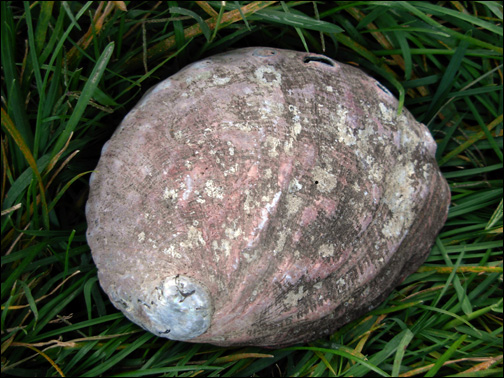
The progression from whole shell to rough shaped disc was relatively rapid. This process took less than 10 min. apiece. Using a hammer stone, the shell base was broken randomly to produce several pieces. A smaller hammer stone was used to nibble at the shell periphery to shape it. Now I had shell blanks in rough oval shape.
It was time to plan a hook-making workshop. With friends interested in learning more about indigenous skills, we planned a trip to the beach. There would be no power tools. We would get an idea of the time required for stone tool hook manufacture.
Before the trip, I attempted to create the necessary stone file. I was curious how much time it would take to create such a tool with pecking and grinding. With a quartzite cobble I both spalled away large sections of a piece of sandstone and pecked the surface to shape it. It was then ground against sandstone (sometimes concrete) to abrade the surface. I broke the rock once and glued it, but still had not created an adequate stone file. Frustrating work. I’d spent nearly the entire day in an unsuccessful attempt to create a stone file. Now there wasn’t time enough to finish the file before the workshop.
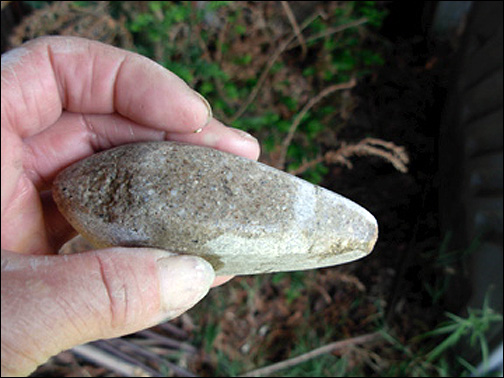
I decided to bring river-washed cobbles of sandstone that resembled the desired file shape. These were to be used as file-substitutes. This led to a serendipitous discovery,
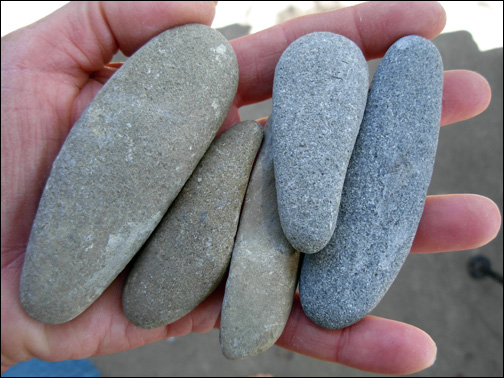
Attempts to use the stone cobbles as files initially proved difficult. The tip of the file “wandered” on the smooth surface of the shell, making placement of the initial hole imprecise. We decided to make a starter hole as Harrington’s notes describe.
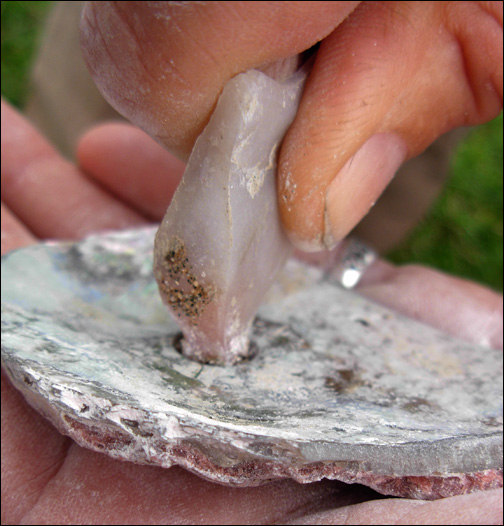
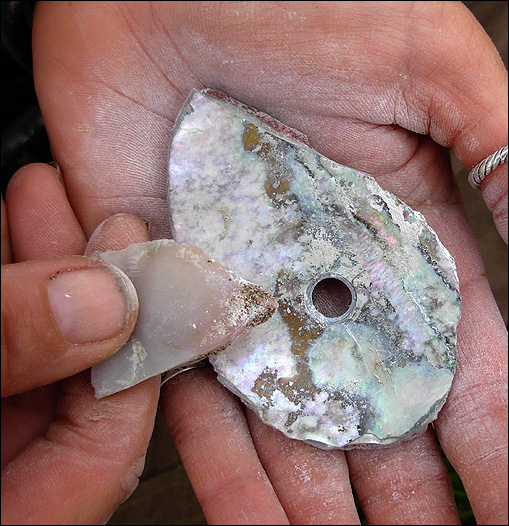
The initial hole was begun with a chert, key-style hand drill. Placement of the hole is critical if it is to be expanded symmetrically with rotational force. Our hand drill was little more than a random spall of chert with a quick pressure-flake touch up. It was practically an instant tool. This “key-drill” was rotated with one hand to abrade the shell. The addition of sand assisted the process, and water kept dust from forming. Once the chert bit had penetrated beyond the 1/2 way point, the shell was flipped over and a hole begun on the opposite side. This prevented the bit from jamming as the hole deepened. Forcing a jammed bit can fracture shell. Within 20 min. the shell was pierced to the other side. Still, this seemed like a lot of effort. I decided to try it another way.
Using pine pitch glue, I mounted a simple chert bit in a straight stick of dogbane. It was used as a hand spindle-drill. The difference in time was remarkable. 10 minutes accomplished a hole through the shell, halving the required effort.
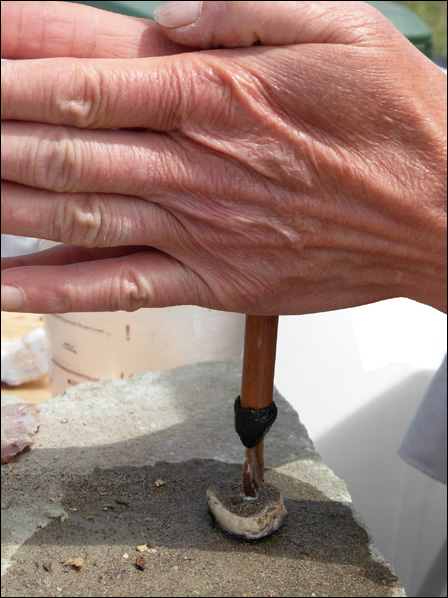
Now we used the stone cobbles to open the hole. The file-shaped cobbles were rotated in the starter hole with one hand. Sand and water were added periodically, but the process was slow. An attempt was made to rotate the cobble between two hands, much as one might do with a fire-by-friction hand spindle. This method proved both painful and unstable with the asymmetrical cobble, and was quickly abandoned. Single-hand rotation was resumed. However, we were delighted with the transformation taking place in the cobble itself. By the time our shell had been adequately opened to the desired diameter (at least 2 hours of steady work), the cobble was beginning to look like the Chumash files unearthed by archeologists. Perhaps this was the method of the file’s manufacture. Once a cobble had been shaped into a symmetrical file, it could then be either rotated between two hands or mounted on a spindle for rotation.
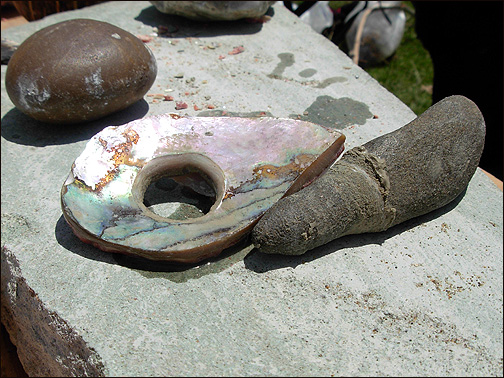
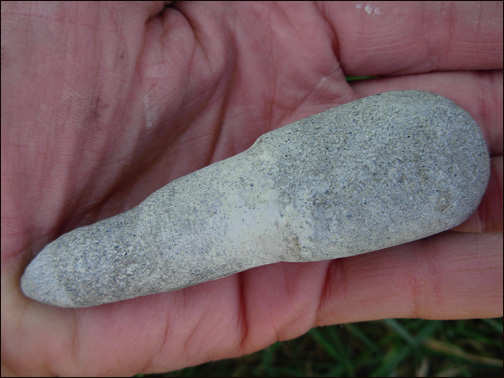
Later, at home, I tried mounting a cobble like a hand-spindle drill. With both hands occupied rotating the spindle, the question of how to secure the shell needed addressing. Damp sand proved the perfect answer. Pressing the shell into the sand secured it quite well. As the surface layer of sand dried, it fell into the hole, automatically, adding fresh grit to the grinding surfaces. This method reduced the time needed to open the central hole.
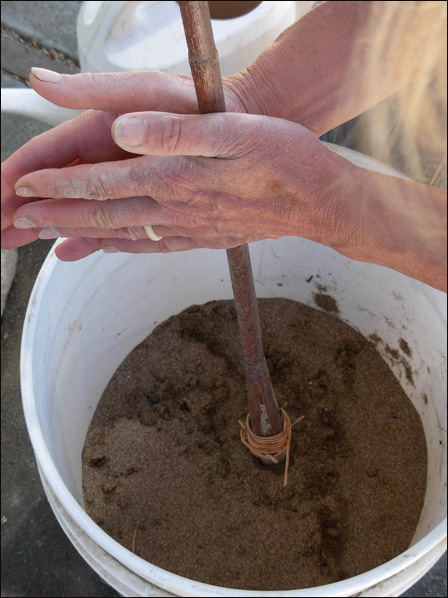
My next question concerned hook gap. I wanted to create a hook with an offset, so I chose a shell blank from the base of the shell where the rim curves and thickens. This allowed the hook to be shaped with the tip offset from the shank, creating a greater hook gap without sacrificing the curve. Abalone shell is laid down in a series of laminates that appear like grain in wood. Instead of the grain following the same plane as the hook, the offset design contained weak cross grain. This hook fractured along this plane when nearly complete. It was glued together, and then finished as an ornamental piece. Note the damage to shell by boring parasites, another cause of weakness in this hook. Note also, the progressive shaping of the cobble used as a spindle drill.
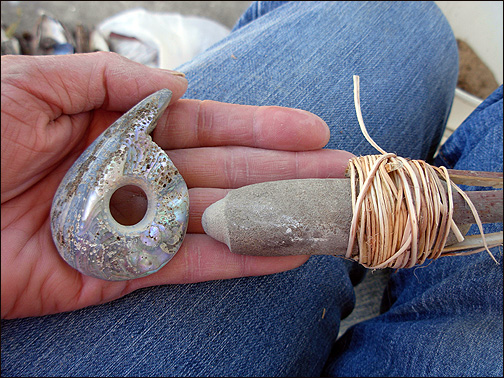
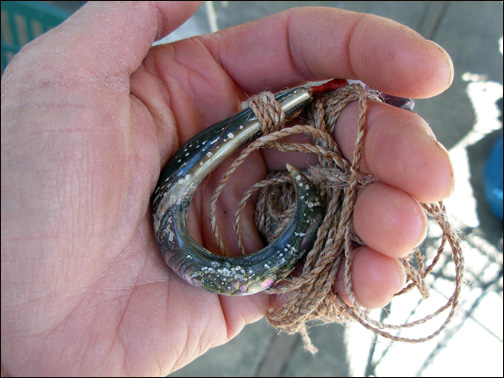
As the off-center hole expands in the shell blank, the portion near its pointed tip becomes narrow. Cobble rotation can fracture this narrow area. Care must be taken to finish the hook with the forces directed toward the center by working the outside edge. Using sandstone abraders, the shell was shaped and smoothed to resemble the classic circular hook of the Chumash. The outer edge was abraded with long strokes, rotating the edge along a flat slab of sandstone. The tip of the hook was sharpened with hand-held fine-grit stone abraders and became surprisingly sharp.
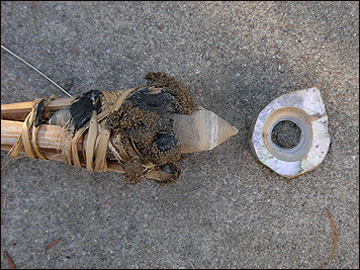
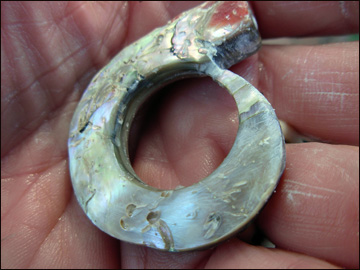
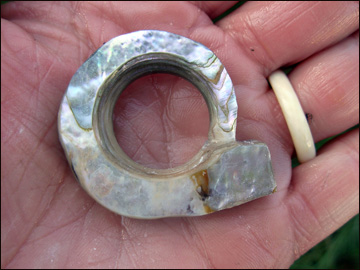
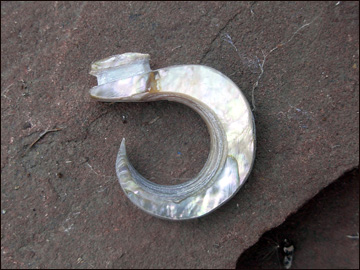
Dogbane cordage was made. Harrington’s ethnographic record describes the lashing technique used by the Chumash, however he doesn’t specify which style of hook is being wrapped. The archeological record shows some of the hooks were shaped with a knob designed to prevent slippage and some were not. My line was secured on knobbed hooks with figure 8 lashings on the shank, the running end then secured with a series of half hitches. Lacking traditional asphaltum, lashings were smeared with pine pitch glue to prevent any slippage. The line was dampened, and the attachment tested by hand. The lashings were secure.
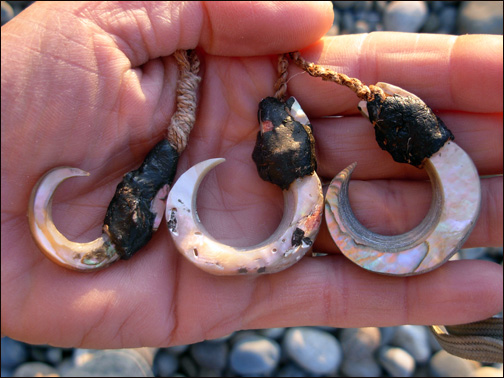
Counting just our most efficient efforts, total time required to create a single hook exceeded 3 hours. Hardly the 15 minutes described by early Spanish diarists. Clearly, the Chumash men were more skilled and far more capable of rapid and forceful use of a stone file than we were. Also their stone files had already been symmetrically shaped. I was convinced single-hand rotation of a stone file could not have produced a hook so quickly. They must have spun it between both hands. But were there other factors? I had to contemplate other possible reasons our hook took so much longer to make:
Perhaps my questions will be answered by someone else, or through further hook construction. For now, I am pleased with my own Chumash style hooks, and the opportunity to do some personal research on their ability to catch fish.
References:
Hudson and Blackburn, The Material Culture of the Chumash Interaction Sphere
Campbell, Paul, Survival Skills of Native California
![]()
We hope the information on the PrimitiveWays website is both instructional and enjoyable. Understand that no warranty or guarantee is included. We expect adults to act responsibly and children to be supervised by a responsible adult. If you use the information on this site to create your own projects or if you try techniques described on PrimitiveWays, behave in accordance with applicable laws, and think about the sustainability of natural resources. Using tools or techniques described on PrimitiveWays can be dangerous with exposure to heavy, sharp or pointed objects, fire, stone tools and hazards present in outdoor settings. Without proper care and caution, or if done incorrectly, there is a risk of property damage, personal injury or even death. So, be advised: Anyone using any information provided on the PrimitiveWays website assumes responsibility for using proper care and caution to protect property, the life, health and safety of himself or herself and all others. He or she expressly assumes all risk of harm or damage to all persons or property proximately caused by the use of this information.
© PrimitiveWays 2016